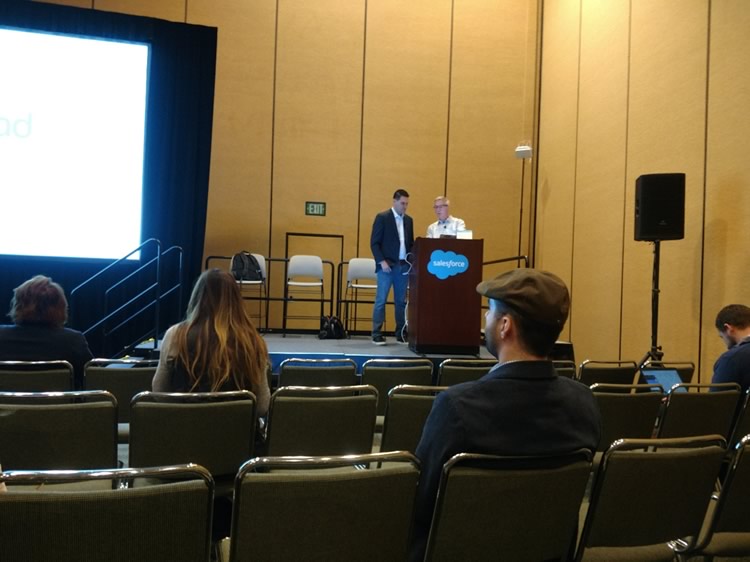With my own session behind me, I was ready to head into Tuesday with less stress and more focus on learning what’s new on the platform.
An Evolving Dreamforce
This is my fourth Dreamforce, and it’s amazing how much has changed since my first. Things are constantly getting bigger, and the resources are getting better. The first floor of Moscone West is no longer where the vendors set up their booths. Instead, it has evolved into an area dedicated almost entirely to Trailhead and a meeting place for developers, helping them discover what they can accomplish on the platform. Apart from getting a chance to catch up with some of my clients, my favorite part of Dreamforce is walking around this show floor and having a chat with the subject matter experts at each Trailhead stop. It’s a unique opportunity to not only get exposed to new features, but also to take a look at what’s coming up in later releases.

My speaking session with Soliant colleague, Damien Phillippi, on Lightning Architecture for Beginners took place on Monday, so Tuesday allowed me relax a bit more and attend some sessions that piqued my interest.
Increased Emphasis on Lightning

One feature heavily showcased throughout Dreamforce 2017 is Base Lightning Components. A session I attended on the topic shared best practices on how to use them to build reusable components, and I can’t wait to put what I learned into practice for my clients.
One of the barriers to adopting Lightning Components has been the heavy CSS and HTML required for implementation. However with Lightning Base Components, the component markup now looks very similar to how a Visualforce page once looked. With Lightning Base Components, developers can focus more on retrieving, manipulating, and presenting data to the user and worry less about correct styling.
Developer Keynote
After a lunch meeting with one of my clients, it was time to head back to Moscone for the Developer Keynote. One of the biggest features touted during the keynote was Platform Events. Though relatively new, Platform Events allow developers to move toward an event/subscriber model, reducing the dependency between an action and its response. The example given during the keynote involved an area of land where some crops didn’t have enough water. Once the location of the dry crops was identified, the event could fire, turning that area of the map to turn red and indicating a lack of water in that location. This functionality gives developers many opportunities to enhance the power of the platform for users.
Simplifying the Transition to Lightning
For my final session of the day, I headed over to the Twilight Campfire and hung out in the area’s comfortable fold out chairs to enjoy “Replace Your Javascript Buttons with Lightning Actions” by Kirpa Kirpanandan. One of the major themes of Dreamforce ’17 is navigating the migration to Lightning Experience. For developers, a sore point on this topic has been that all the Javascript buttons we’ve built will no longer work in Lightning. Luckily, there are quite a few options for workarounds for this issue. Personally, my favorite workaround is to create a button that links to a Visualforce page, where a developer has more control over what messages are sent to the user.
Kirpanandan shared that a Visualforce page was a viable alternative, but I hadn’t considered his recommended alternative of Lightning Component Actions. For Lightning Component Actions, any Javascript code you write will be delegated over to a Lightning Component Javascript controller. It’s unfortunate that all buttons created in Salesforce classic will now have to be migrated over to Lightning alternatives, but Salesforce has provided developers with quite a few options for the inevitable transition. I’m looking forward to sharing my insights on Lightning Component Actions with my clients and helping them make their transition to Lightning easier.
On to Day Three
Every time I attend Dreamforce, I’m amazed at the sheer number of developers that attend. That being said, I don’t know of any other software company that puts this much effort into free training modules for their software.
Based on developer attendance and enthusiasm alone, it only takes one day of attendance at Dreamforce to make you believe that Salesforce is growing quickly. Hopefully, more businesses will realize that moving to the cloud is the right choice to remain competitive. If you’re on the fence, I’m happy to share some insights on how it could be beneficial for your organization. Just contact me and my team to get started.